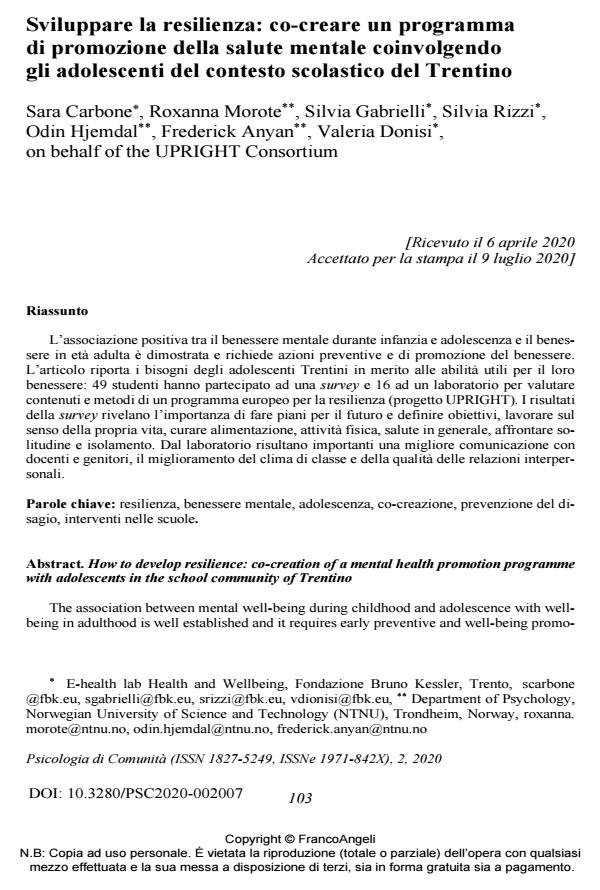Sviluppare la resilienza: co-creare un programma di promozione della salute mentale coinvolgendo gli adolescenti del contesto scolastico del Trentino
Titolo Rivista PSICOLOGIA DI COMUNITA’
Autori/Curatori Sara Carbone, Roxanna Morote, Silvia Gabrielli, Silvia Rizzi, Odin Hjemdal, Frederick Anyan, Valeria Donisi
Anno di pubblicazione 2020 Fascicolo 2020/2
Lingua Italiano Numero pagine 20 P. 103-122 Dimensione file 385 KB
DOI 10.3280/PSC2020-002007
Il DOI è il codice a barre della proprietà intellettuale: per saperne di più
clicca qui
Qui sotto puoi vedere in anteprima la prima pagina di questo articolo.
Se questo articolo ti interessa, lo puoi acquistare (e scaricare in formato pdf) seguendo le facili indicazioni per acquistare il download credit. Acquista Download Credits per scaricare questo Articolo in formato PDF

FrancoAngeli è membro della Publishers International Linking Association, Inc (PILA)associazione indipendente e non profit per facilitare (attraverso i servizi tecnologici implementati da CrossRef.org) l’accesso degli studiosi ai contenuti digitali nelle pubblicazioni professionali e scientifiche
L’associazione positiva tra il benessere mentale durante infanzia e adolescenza e il benessere in età adulta è dimostrata e richiede azioni preventive e di promozione del benessere. L’articolo riporta i bisogni degli adolescenti Trentini in merito alle abilità utili per il loro benes-sere: 49 studenti hanno partecipato ad una survey e 16 ad un laboratorio per valutare contenuti e metodi di un programma europeo per la resilienza (progetto UPRIGHT). I risultati della survey rivelano l’importanza di fare piani per il futuro e definire obiettivi, lavorare sul senso della propria vita, curare alimentazione, attività fisica, salute in generale, affrontare solitudine e isolamento. Dal laboratorio risultano importanti una migliore comunicazione con docenti e genitori, il miglioramento del clima di classe e della qualità delle relazioni interpersonali.
Parole chiave:Resilienza, benessere mentale, adolescenza, co-creazione, prevenzione del disagio, interventi nelle scuole.
Sara Carbone, Roxanna Morote, Silvia Gabrielli, Silvia Rizzi, Odin Hjemdal, Frederick Anyan, Valeria Donisi, Sviluppare la resilienza: co-creare un programma di promozione della salute mentale coinvolgendo gli adolescenti del contesto scolastico del Trentino in "PSICOLOGIA DI COMUNITA’" 2/2020, pp 103-122, DOI: 10.3280/PSC2020-002007